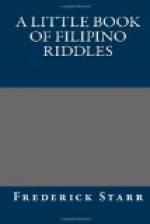Of “true riddles” there is a vast variety of form and content. Most typical is the descriptive riddle of a single object to be guessed. In its complete and normal form Petsch claims that such a riddle consists of five elements or parts. 1 Introduction; 2 denominative; 3 descriptive; 4 restraint or contrast; 5 conclusion. 1 and 5 are merely formal, trimmings; 2 and 3 are inherent and essential; 4 is common and adds vigor and interest. Such complete and “normal” riddles are rare in any language. Usually one or more of the five elements are lacking. It is only by such an analysis of riddle forms that a comparative study of riddles can be made. Any single riddle is best understood, by the constant holding before the mind this pattern framework and noting the degree of development of the case in hand.
The Filipinos themselves recognize several classes of riddles. An old Tagal lady told us there were three kinds:
1. Alo-divino:
concerning God and divine things
2. Alo-humano:
concerning persons
3. Parabula: all
others
There is no science in this classification, which embodies considerable corrupted Spanish. Another informant recognizes six classes:
1. Alo-divino 2. Historia-vino: history of God and saints 3. Alo-humano 4. Historia-mano: history of persons. 5. Karle-mano: God and saints and persons together. 6. Parabula or biniyabas.
These names call for little comment and the classification they embody is of the loosest. The word parabula is Spanish in source and equivalent to our parable; biniyabas is Tagal.
Some features of our riddles call for comment. Filipino riddles, in whatever language, are likely to be in poetical form. The commonest type is in two well-balanced, rhyming lines. Filipino versification is less exacting in its demand in rhyme than our own; it is sufficient if the final syllables contain the same vowel; thus Rizal says—ayup and pagud, aval and alam, rhyme. The commonest riddle verse contains five or seven, or six, syllables, thus:




